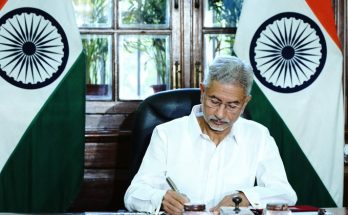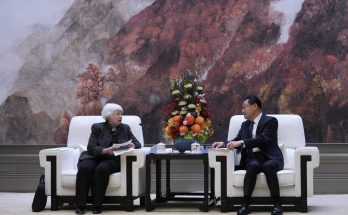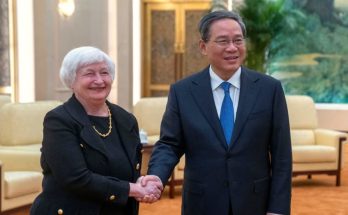 The India-US Joint Statement, released following the meeting between India’s Prime Minister Narendra Modi and US President Barack Obama on September 30, suggests the tasks that the two countries will pursue to deepen and strengthen the bilateral relationship. The statement consists of five different themes, which are economic growth, energy and climate change, defence and homeland security cooperation, high technology, space and health cooperation and global issues and regional consultations. The inclusion of the global issues and regional consultations in the statement has shown that India and the US do not have many disparities in their views on various global and security issues. The South China Sea (SCS) dispute was also mentioned, along with other issues from the security perspective.
The India-US Joint Statement, released following the meeting between India’s Prime Minister Narendra Modi and US President Barack Obama on September 30, suggests the tasks that the two countries will pursue to deepen and strengthen the bilateral relationship. The statement consists of five different themes, which are economic growth, energy and climate change, defence and homeland security cooperation, high technology, space and health cooperation and global issues and regional consultations. The inclusion of the global issues and regional consultations in the statement has shown that India and the US do not have many disparities in their views on various global and security issues. The South China Sea (SCS) dispute was also mentioned, along with other issues from the security perspective.
Their common view on the SCS dispute is related to their Asia-centred policies, which are at the intersection of their foreign policy directions. The two countries are pursuing a synergy effect in Asia via their bilateral collaboration in the region. The joint statement states that “the leaders committed to work more closely with other Asia Pacific countries”, noting “India’s “Act East” policy” – the new version of the Look East policy – and “the United States’ rebalance to Asia”. Japan was first mentioned as their partner for trilateral cooperation in the Asia Pacific, followed by the necessity of infrastructure connectivity for integrating economies in South, Southeast, and Central Asia. Their new agreement to expand joint development in third countries was also introduced.
The “shared interest” of India and the US “in preserving regional peace and stability” has enabled them to present their ‘shared attitude’ towards current global and regional security issues. Significantly, the SCS, with critical geo-political significance, was mentioned before Syria, Iraq, Afghanistan and North Korea in the statement. In regard to the SCS, India and the US “called on all parties to avoid the use, or threat of use, of force” and to respect “international law” when engaging in territorial and maritime disputes. They suggested three main shared interests in maritime spheres, “especially in the South China Sea”: safeguarding maritime security, ensuring freedom of navigation, and overflights throughout the region.
“Act East” and “Rebalance to Asia”
The reason the two parties can generate the same arguments with one voice, in regard to the SCS dispute, lies in the troubles they currently experience in the same area. The US has been at loggerheads with China — for example, the recent near-collision between a Chinese fighter and an American surveillance aircraft that was flying in China’s offshore exclusive economic zone (EEZ). China and the US had conflicts in the SCS when a US survey ship was confronted by a Chinese naval frigate in China’s EEZ in 2001, and when a Chinese fighter collided with a US EP-3 surveillance plane off the coast of Hainan in the same year. In 2009, Chinese vessels blocked and surrounded a US surveillance ship, the Impeccable, at the similar area to the 2001 EP-3 incident.
L ikewise, India’s footprint in the SCS is one of the external variables that could interfere with China’s absolute superior influence in the region. India has its interest in the natural resources buried in the SCS, and China diplomatically complained against India’s hydrocarbon exploration and exploitation projects in the SCS off the coast of Vietnam since 2011. Despite China’s negative response, in the summit meeting between India and Vietnam held in November 2013, Vietnam offered seven oil blocks in the SCS, and agreed to strengthen bilateral cooperation in natural gas and oil explorations. Furthermore, in the recent meeting between President Pranab Mukherjee and President Truong Tan Sang in Hanoi on September 15, 2014, India and Vietnam signed seven bilateral cooperation agreements, including an agreement on the exploration of two additional oil blocks off Vietnam by an overseas arm of Indian oil company ONGC (OVL), and Petro Vietnam. It is not a new attempt given that OVL explored and exploited in the SCS in collaboration with Vietnamese companies since 1988 as a commercial activity. Under the directions of the newly introduced “Act East” policy, India will strengthen and diversify its economic cooperation in South and East Asian countries more progressively, as has been epitomised by its “Look East” policy since the 1990s.
ikewise, India’s footprint in the SCS is one of the external variables that could interfere with China’s absolute superior influence in the region. India has its interest in the natural resources buried in the SCS, and China diplomatically complained against India’s hydrocarbon exploration and exploitation projects in the SCS off the coast of Vietnam since 2011. Despite China’s negative response, in the summit meeting between India and Vietnam held in November 2013, Vietnam offered seven oil blocks in the SCS, and agreed to strengthen bilateral cooperation in natural gas and oil explorations. Furthermore, in the recent meeting between President Pranab Mukherjee and President Truong Tan Sang in Hanoi on September 15, 2014, India and Vietnam signed seven bilateral cooperation agreements, including an agreement on the exploration of two additional oil blocks off Vietnam by an overseas arm of Indian oil company ONGC (OVL), and Petro Vietnam. It is not a new attempt given that OVL explored and exploited in the SCS in collaboration with Vietnamese companies since 1988 as a commercial activity. Under the directions of the newly introduced “Act East” policy, India will strengthen and diversify its economic cooperation in South and East Asian countries more progressively, as has been epitomised by its “Look East” policy since the 1990s.
India’s careful approach to China, however, anticipates that India would not be proactively engaged in political conflict against China. During his recent visit to the US, Modi’s answer to a question raised in a conversation in the Council on Foreign Relations has implied that India considers status quo and stabilisation to be its first security priority for pursuing its national interest in bilateral cooperation with Asian countries, including China. In regard to the question about the India-China border dispute, he did not criticise China, but said that “China and India are in direct talks, and that is why there is no need for a separate arbitration” at this moment. The spokesperson of India’s Ministry of External Affairs also said in August after the ASEAN Foreign Ministers Meeting, as an answer to a question on India’s interaction with China on the SCS issue, that China was an important country and a neighbour with which India had very cordial relations. Similarly, President Pranab Mukherjee pointed out that India did not make any comment about the sovereignty issue over the SCS.
The SCS-related agreement in the India-US Joint Statement indicates that a stable and peaceful SCS has become a common interest for India and the US, while India is expanding its partnerships with Asian countries to maximise its national interest. The request for a peaceful SCS from India goes beyond a normative and moral stance of a major country in the region. Meanwhile, India’s eclectic approach is aimed at both its national interest and maintaining amicable relations with its big neighbour. The Indian factor in the current SCS dispute is another influential variable and is instilling more dynamics that China should deal with carefully.
(Jiye Kim is PhD candidate and Korean Government Fellow, Centre for East Asian Studies, JNU. This article has been written for www.indiawrites.org)
– The views expressed in this article are solely those of the author
References
I) The White House, “U.S.-India Joint Statement,” September 30, 2014, accessed on October 3, 2014, http://www.whitehouse.gov/the-press-office/2014/09/30/us-india-joint-statement.
II) Ministry of External Affairs, “Official Spokesperson’s response to a media query on the South China Sea,” May 9, 2014, accessed on October 25, 2014, http://www.mea.gov.in/media-briefings.htm?dtl/23312/Official+Spokespersons.
III) Ministry of External Affairs, “Transcript of President’s Onboard Media Interaction En Route to Delhi from Ho Chi Minh City,” September 18, 2014, accessed on October 25, 2014, http://www.mea.gov.in/media-briefings.htm?dtl/24013/Transcript+of+Presidents; MEA, “Q.5353 Exploration in south china Sea,” May 9, 2012, accessed on October 25, 2014, http://www.mea.gov.in/interviews.htm?dtl/19800/Q5353+Exploration+in+south+china+Sea.
IV) Narendra Modi, “Event Video: Indian Prime Minister Narendra Modi on India’s Economy and U.S-India Relations” (event held at Council on Foreign Relations, New York, September 29, 2014), accessed on October 3, 2014, http://www.cfr.org/india/indian-prime-minister-narendra-modi-indias-economy-us-india-relations/p33518.
V) Ministry of External Affairs, “Transcript of Media Briefing by Official Spokesperson on External Affairs Minister’s meetings in Nay Pyi Taw,” August 9, 2014, accessed on October 25, 2014, http://www.mea.gov.in/outoging-visit-detail.htm?23879/Transcript+of+Media+Briefing.
VI) Ministry of External Affairs, “Transcript of President’s Onboard Media Interaction En Route to Delhi from Ho Chi Minh City,” September 18, 2014, accessed on October 25, 2014, http://www.mea.gov.in/media-briefings.htm?dtl/24013/Transcript+of+Presidents.
Author Profile
- India Writes Network (www.indiawrites.org) is an emerging think tank and a media-publishing company focused on international affairs & the India Story. Centre for Global India Insights is the research arm of India Writes Network. To subscribe to India and the World, write to editor@indiawrites.org. A venture of TGII Media Private Limited, a leading media, publishing and consultancy company, IWN has carved a niche for balanced and exhaustive reporting and analysis of international affairs. Eminent personalities, politicians, diplomats, authors, strategy gurus and news-makers have contributed to India Writes Network, as also “India and the World,” a magazine focused on global affairs.
Latest entries
 In ConversationJuly 26, 2024India-Italy defence collaboration can extend to third countries: Anil Wadhwa
In ConversationJuly 26, 2024India-Italy defence collaboration can extend to third countries: Anil Wadhwa In ConversationJuly 23, 2024Italy views India as a key partner in Indo-Pacific: Vani Rao
In ConversationJuly 23, 2024Italy views India as a key partner in Indo-Pacific: Vani Rao DiplomacyJune 29, 2024First BRICS unveils a roadmap for boosting tourism among emerging economies
DiplomacyJune 29, 2024First BRICS unveils a roadmap for boosting tourism among emerging economies India and the WorldJune 11, 2024On Day 1, Jaishankar focuses on resolving standoff with China
India and the WorldJune 11, 2024On Day 1, Jaishankar focuses on resolving standoff with China






